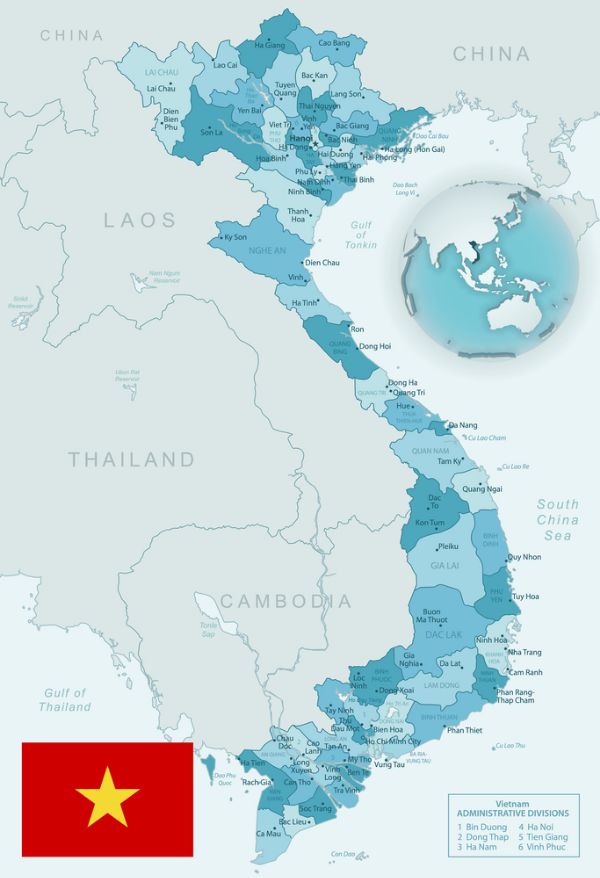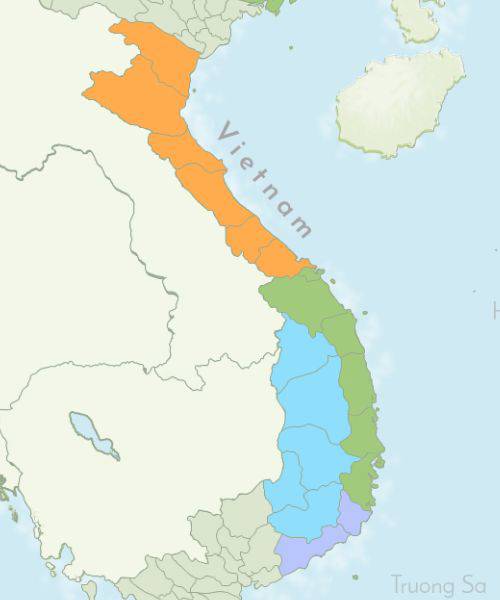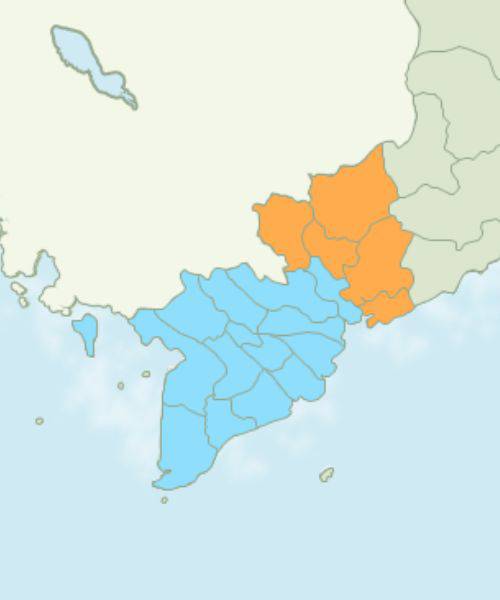combined tours
TropiGo Travel is the leading expert in customized tours across Vietnam, Cambodia, Laos and Thailand, with over 24 years of experience crafting unforgettable trips.
Vietnam enchants visitors with its breathtaking landscapes, vibrant cities, and rich cultural heritage. Let TropiGo guide you through an unforgettable journey, uncovering the magic of this extraordinary land!

A land of misty mountains, lush valleys, and rich traditions. Experience vibrant cultures, breathtaking landscapes, and a perfect blend of history and nature.

Where ancient heritage meets stunning coastlines. Immerse yourself in fascinating history, dramatic scenery, and a unique fusion of tradition and modern charm.

A dynamic region of bustling cities, winding rivers, and tropical escapes. Discover lively markets, diverse cultures, and the serene beauty of island getaways.

Discover Vietnam’s breathtaking landscapes and rich culture through expertly crafted journeys, enriched by meaningful local connections. Let our beloved itineraries inspire your unique adventure, guided seamlessly by our seasoned travel experts for an unforgettable experience.
Planning a trip to Vietnam for the first time can be challenging, but don’t worry! We’ve gathered essential tips on weather, visas, flights, and local activities to help you plan and make the most of your adventure.
If you haven’t found the answer in our guide, explore our curated list of frequently asked questions about Vietnam, where we provide clear and concise insights. Still have questions? Don’t hesitate to reach out - our team is always ready to assist you!
The price of a trip to Vietnam starts at around $550 per week. This price does not include flight costs. It covers accommodation in 3-star hotels, meals at local restaurants, and popular activities such as visits to the Mekong Delta. Taxi costs are also included in this price, resulting in a daily budget of $75.
For luxury travel in Vietnam, an estimated cost of $195 per day per person is expected. There are many luxury hotels and resorts, especially along the coast. With this daily budget, you can stay in at least a 4-star hotel, enjoy three-course meals, rent a private car, and take part in private guided tours, such as the Saigon Vespa Tour.
Visa exemption for Vietnam allows foreigners to enter and stay in the country for a specified period without needing a visa, as the Vietnamese government has signed bilateral or unilateral visa exemption agreements with their country.
Countries eligible for visa exemption include Italy, France, Germany, Spain, the United Kingdom, Sweden, Denmark, Finland, and Norway.
However, a visa is required if the stay exceeds 45 days or for citizens of countries not listed above.
Vietnam is situated in Northeast Southeast Asia, bordering China to the north, Laos to the west, and Cambodia to the southwest. It also has a Pacific coastline, with the East Sea to the east and the Gulf of Thailand to the southwest.
Despite its relatively small area of 331,690 square kilometers, similar to Italy, Vietnam has a distinctive shape resembling both the letter S and a dragon. Stretching 1,650 km from north to south, it has a maximum width of 600 km in the north and narrows to just 50 km in the central region, giving it a slender shape reminiscent of Italy.
Vietnam follows the UTC+7 time zone. This time zone coincides with the time zones of neighboring countries including Thailand, Laos, Cambodia and Indonesia.
Currently, Vietnam Airlines operates a direct flight from Milan to Hanoi. Additionally, travelers can choose one-stop flights with several reputable airlines. Here are some of the most popular choices among our customers:
Among these, Vietnam Airlines offers a non-stop flight from Milan to Hanoi, which takes approximately 12 hours, arriving in the morning around 7:00 AM.
Other airlines provide one or two-stop flights at more competitive prices. Carriers like Eva Air, Qatar Airways, and Emirates are often preferred by travelers for their affordable fares and excellent service.
Vietnam currently has five major international airports, with Noi Bai Airport (Hanoi) and Tan Son Nhat Airport (Ho Chi Minh City) being the most important and modern in the country. Additionally, the Long Thanh International Airport, currently under construction, aims to become the largest airport in Southeast Asia.
For a 10-15 day trip to Vietnam, it is recommended to carry around 300-400 USD in cash for additional expenses outside of your tour package. For other expenses such as meals, spa services in hotels, or dining at restaurants that accept card payments, using a Visa or Mastercard is preferable.
Before traveling, ensure your card is enabled for international payments and check your daily spending limit.
All tourist destinations in Vietnam are safe, and no mandatory vaccinations are required. However, travelers should consult their personal doctor for advice.
Commonly recommended vaccines for Vietnam include those for childhood diseases (tetanus, diphtheria, measles, mumps, and rubella) and food- and waterborne illnesses such as typhoid and hepatitis A.
For longer stays or rural excursions, additional vaccines such as hepatitis B and rabies may be advised.
It is recommended to start vaccinations 4-6 weeks before departure. Travelers heading to rural areas should consult their doctor well in advance to complete all necessary doses.
Vietnam has malaria-risk zones, so antimalarial medication may be necessary depending on your itinerary.
Vietnam’s most stunning beaches are mainly found in the central provinces such as Da Nang, Hoi An, and Nha Trang, as well as in the southern provinces like Mui Ne and Phu Quoc.
Due to climatic differences across regions, it’s best to visit during the ideal season. Central Vietnam’s beaches are at their best from April to September, while Southern Vietnam’s beaches shine from October to March of the following year.
Vietnamese people are often regarded as some of the most attractive in Southeast Asia, thanks to their unique ethnic blend of northern and southern Mongoloid influences. They are known for being hardworking, intelligent, and welcoming toward foreigners.
While open to Western culture, they still preserve their Confucian values. However, like any society, they have some flaws, such as speaking loudly in public, a lack of collective awareness, and at times, being practical and shrewd in their interactions.
The question of what to eat in Vietnam is both easy and difficult to answer, as the country boasts one of the richest culinary traditions in the world, with thousands of dishes enjoyed daily.
For those new to Vietnamese cuisine, a great place to start is with pho (beef noodle soup), nem (spring rolls), bun cha (grilled pork with vermicelli), bun bo Hue (spicy Hue beef noodle soup), banh mi (Vietnamese baguette sandwich), and the famous Vietnamese drip coffee.
The distance from North to South Vietnam is 1,650 km, so the fastest way to travel is by plane (about 2.5 hours). Trains take approximately 32 hours, while buses take around 24 hours.
If you're traveling from north to south, you can use buses or trains for shorter routes and flights for longer distances, such as Hanoi - Hue, Hanoi - Da Nang, Da Nang - Ho Chi Minh City, and Ho Chi Minh - Phu Quoc.
Vietnamese women are considered among the most beautiful in Southeast Asia, even surpassing those from East Asia. Thanks to their geographical location, fresh diet, tropical climate, and active lifestyle, they tend to have a slim, petite figure and radiant, healthy skin.
In terms of personality, Vietnamese women are generally kind, hardworking, intelligent, and modest. However, with modern trends, these qualities are evolving—more slowly in the north and more openly in the south.
Vietnam is famous for handicrafts made from natural materials, making it an ideal place to find unique souvenirs. Some recommended gifts include:
For better prices, it’s best to shop outside city centers rather than in tourist areas.
Northern Vietnam is often considered the most beautiful region of the country due to its diverse landscapes, rich cuisine, and cultural variety. However, the climate can be more extreme compared to the rest of Vietnam, with hot, humid summers and rainy springs.
Some must-visit destinations include:
To fully explore Vietnam and immerse yourself in its culture, a lifetime might not be enough! However, for a first-time visit, a two-week itinerary is ideal. Here’s a suggested plan:
This itinerary provides a balanced mix of history, culture, nature, and relaxation, covering Vietnam’s must-see destinations.
To help you fully explore Vietnam, Tropicana Travel curates the best activities in Vietnam - from hidden local gems to unique experiences tailored to your taste.
Get inspired for your next journey - explore stories, tips, and hidden gems from our travel blog.
Nothing speaks louder about TropiGo’s quality than the voices of our travelers. Discover their authentic experiences - where attentive service, expert guides, and unforgettable moments come together to create memorable trips!